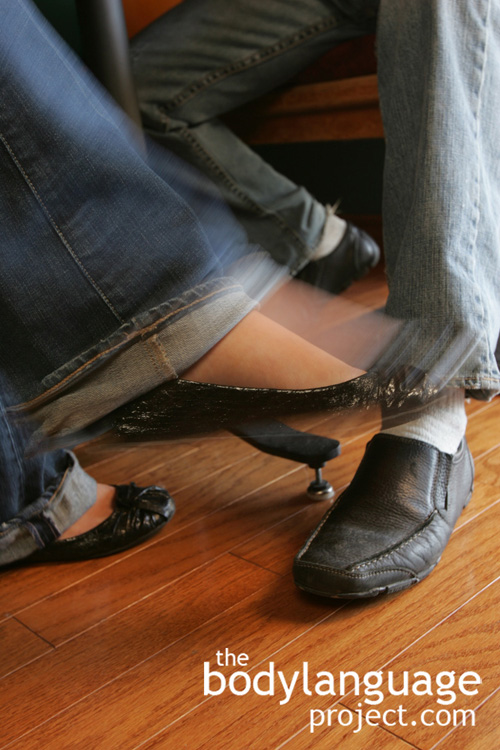
A backward facing cap with open body language means ticket all day long.
If you wish to avoid an attack, quickly avert your eyes, pull your head and chin down and draw your shoulders and body inward to make it appear smaller. Submissive postures, like this one, switches off the aggressive attack response in other people. A large part of what provides motivation for those in power, is the power itself and it has been said that those in positions of power want nothing else but more power. So to avoid an attack all we need to do is give them that power, ideally it is in the form of less physical methods. Taking up a submissive posture and admitting guilt is usually enough of a payoff to avoid a speeding ticket at best, or at worst, lessening the amount of punishment that will be received. If asked to step out of the vehicle, keep slouched so as to never reach your full height and don’t completely avoid eye contact, but don’t stare either. Keep reserved, hold your arms and hands across your mid section or in your pockets, but never cross your arms in effort to confront.

A submissive child-like posture leads to protective feelings in others.
Only rarely does a direct confrontation between subordinate and superior individuals lead to a positive outcome for the subordinate since the aim of each must align and only rarely does this happen. Your goal is therefore to produce a situation where the dominant person receives an equal or better outcome, or a weak payout (such as making them feel guilty for giving a nice person a ticket). Affirming ones position against another only leads them to affirm their position further. This completes a never ending cycle that can escalate in short order. By admitting that you are wrong it forces people to mirror this stance causing them to drop their aggression.
If you don’t plan on fighting the ticket in court your best course of action is to vehemently admit your mistakes, and do it repeatedly for effect. The side of the road is not the place to start an argument, that’s what the courts are for, so save it for then. Right now your job is to make the officer feel bad for giving a nice person a ticket so what you want to do is act as if you are an honest, well respected member of the community. Even if you do plan to fight it, you still want to be forgotten so the officer doesn’t go back to his cruiser to jot down notes and begin to mount his court case. If he can’t remember you in court he won’t be able to defend his ticket.
When asked for information, provide it quickly and without hesitation. Avoid “humming” and “haaing” and be as helpful and short as possible, he’s heard all the excuses already so don’t bother getting emotional. The worst you can do is to appear as a threat to his safety by being shifty and moving erratically. When asked for your driver’s license and registration be sure to tell him where they are located and in what order you will give them to him. When reaching in an enclosed compartment like the glove box be sure not to hold eye contact since most attackers look directly into their victims eyes before they assault them. Statistics say that officers are very likely to be assaulted or even killed while on routine traffic stops.
Once you’ve given all the correct body language signals watch for the moment where the officer finally judges that you aren’t a threat. The officer’s body language will become more relaxed and loose and you can begin to address them in a less rigid and formal manner. Cracking jokes is risky, at this point though, since you may put them back into an authoritative position by appearing to belittling the situation. If they seem bent on issuing a ticket though, you may have nothing to lose and easing up might have them lower the fine even at the last moment. If you are persuasive enough and can efficiently built rapport, you may be able to walk the thin line between presenting your case which can be taken as an insult and setting off his dominance triggers.

You wouldn’t mess with this chick. Head back spells confidence and authority.
There are other times altogether when showing submission just won’t work to avoid attack. Walking in the city at night is one of them especially for women. Postures such as slumped shoulders, drooping head and a worried face are the postures attackers use to identify easy victims. While placating some attackers might sometimes be appropriate, it won’t work in every situation since every attacker has different motives and while submission postures will help reduce punishment from someone with morals and ethics, it will do nothing to reduce an attack from a criminal who is interested in your pocket money, looking for someone to abduct, or worse. The same has been said for bear attacks. It just so happens that bears, just like people, have different motives depending on their disposition, mood, hunger, sex. Female bears are particularly aggressive when their cubs are present. Therefore, your natural inclination should always be to hold dominant postures first, to fight and run if possible, and only show submission to people whose punishment you are willing to accept. The last thing you want to do is appear as though you’d be easily taken advantage of especially when faced by a stranger. So the default street posture is to keep your head up, shoulders back and a loose body. If someone is going to attack a confident looking person, they’d most likely attack you regardless of your posture, so taking on a confident posture is always the most appropriate in questionable circumstances.










